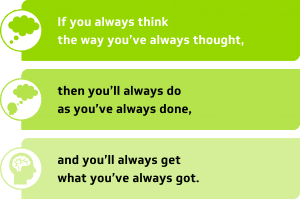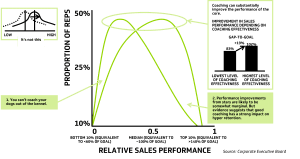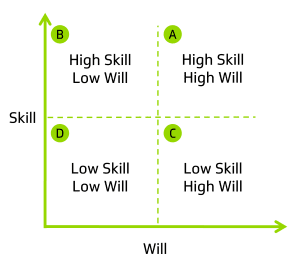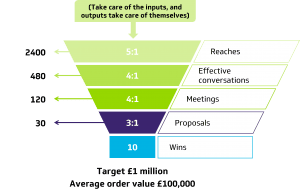What if you could clone your A-star salesperson? You know, the one all clients love, whose every interaction leads to a meeting, and every meeting yields results. Dedicated and gifted, sales is just in their blood.
They’re one-of-a-kind, right?
Well, maybe not.
Experienced leaders know that success isn’t just about hiring great salespeople. It’s about establishing frameworks to nurture talent, measure results and optimise performance. Greatness isn’t born – it’s made with smart thinking and incremental improvements. Under the right leadership, your whole team could return those A-star results.
In this blog we discuss:
- The importance of an engaged team and the cost of ambivalence
- Why time allocation is critical: which actions lead to which results
- The importance of data
- Segmenting your people and approach to improve win rates
Time to engage: why ambivalence is never enough
Be honest, how engaged are your team?
According to the Corporate Leadership Council (now Gartner), probably less so than you’d think.
11% of salespeople confess to being ‘disengaged’ and a further 76% describe themselves as ‘ambivalent’. Although probably not a phrase they used in their job interview.
This would be a problem in any profession, but is critical for salespeople. After all, if your team doesn’t believe in the product or service, why would their prospects?
Challenge your thinking
At SBR we have a mantra: “Our thinking drives our behaviour; it’s our behaviour that drives our results.” So, if you’re struggling to meet targets, one of the first approaches is to challenge your team’s thinking so they behave differently and drive a different result in your organisation.
The trick is to pinpoint clear and consistent goals and find out how to keep your team edging towards them.
We believe the principles of effective sales leadership can be distilled into three key takeaways.
- Spend time with your people
- Give them a clear track to run on
- Measure the KPIs of successful behaviour

Allocating your time effectively
It’s an old story. Overwhelmed sales managers become task-focused, tied up in everyday deliverables and time-poor for anyone or anything else.
But effective leadership means being with people – listening, emphasising, coaching and inspiring. Sharing the bigger vision is a commitment of your energy and focus. It’s a dedication of time.
The question is, how much?
According to research by the Corporate Executive Board (also now Gartner), the sweet spot for coaching is between three and five hours per person per month.
For those managing large teams, this may seem like an unattainable goal. But not everyone needs the same type or level of support. Leaders must learn to prioritise their efforts and build interdependent teams that are greater than the sum of their parts.
Focusing on what matters
The impact of coaching has variable results. To maximise the payoff, focus on the areas of highest return.
Research by the Corporate Executive Board shows that time spent with low performers has low business gains. In other words, you can’t coach a dog out of a kennel.
Equally, time spent with stars produces marginal results (although the research suggests that good coaching impacts retention).
It’s time spent with the core group that substantially improves results. This is where your priority should lie.

Why data is all-important
Often described as the founding father of Total Quality Management, W. Edwards Deming knew a thing or two about effective leadership. According to him, “without data, you’re just another person with an opinion.”
Data brings clarity to objectives. It lets us measure sales performance, unpick areas for improvement and set clear goals for people to work towards.
It also means we can segment our salespeople and identify our dog, star and core performers.
To avoid bias, we need clear performance benchmarks. In a recent webinar, our joint managing director Alan Morton explained that this shouldn’t just be a measure of attainment.
Skill/will analysis
According to Alan, we must dig deeper and find the factors influencing skill and will.
This simple skill/will analysis lets us segment our salespeople into four key categories.

- A Players (stars): high skill and high will
- B Players (core): high skill and low will
- C Players (core): low skill and high will
- D Players (dogs): low skill and low will
Of course, you can’t measure skill and will, but you can measure conversion and activity.
Critical success factors
As Alan says, “take care of the inputs and the outputs look after themselves.”
The critical success factors to focus on can be visualised in the context of a sales funnel, with ‘total reaches’ at the top and ‘wins’ at the bottom.

You can track conversion rates by adding this data to a dashboard. This gives you a score of everyone’s performance and conversion rate at each level of the funnel.
Results can then be benchmarked both over time and against other team members’ performance. Strengths and weaknesses will soon emerge and then you can root out sticking points.
Segmenting your people and approach
When you understand where your salespeople fit on the skill/will analysis, and you’ve developed measurable performance indicators, you can start to prioritise training needs.
Better yet, because you’re using quantifiable data, you remove uncertainty from those often-challenging performance meetings.
Rather than focus on what you think might need improvement, you can tailor a plan based on real needs.
Here’s an overview of how that might work.
A Players: high skill and high will
- Save your time and create robust teams by asking them to coach C players.
- Shadow them and apply their methods to other team members.
- Help them recognise their strengths so they reinforce them in everyday practice.
- Challenge them to go further by setting up a leader board. A Players feed off legacy!
B Players: high skill and low will
- Understand why their activity levels have dropped and help them recognise it too.
- Challenge their perception with data not opinions.
- Refocus activities on clear expectations and SMART goals.
- Provide regular catchups to focus on activity levels and drive engagement.
C Players: low skill and high will
- Provide a track to run on with clear goals.
- Ask them to shadow A players or, if that’s too big a step, higher-performing C Players.
- Catch them doing things right to boost their confidence.
D: Low skill / low will
- Something’s not right. Evaluate your recruitment, onboarding and training programmes.
- Discover what motivates them and focus on activity levels.
- Develop a goal-driven plan to move them up to C Player and then A Player standards.
- Remove them from the team if there’s no evident progress.
In summary
Sales leadership is about spending time with your people. But learning how to prioritise needs and invest your time efficiently is crucial.
Focusing on critical success factors with a data-led approach will bring clarity to your team’s training needs. This means you can maximise your training ROI and build a highly effective team that grows together.
Learn more about sales leadership, including the four grand theories of learning, by watching a replay our webinar: The Formula for Successful Sales Leadership.
To discuss how we can help you with sales leadership, please get in touch by emailing info@sbrconsulting.com or call us on +44 (0) 207 653 3740.
You can sign up to receive regular updates and join over 4,000 others who enjoy access to our unique research insights, expert guidance, and advice.